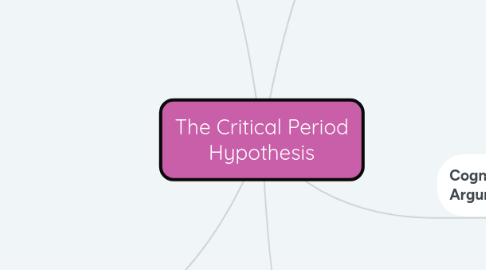The Critical Period Hypothesis
by Eunice Funes

1. Younger Children versus Older Children
1.1. oThree misconceptions about the relationship of the age of the language
1.1.1. First, it is misinterpreted that the ultimate attainment is gained by children since they learn quickly and easily.
1.1.2. Second, “error misattribution, assuming that differences in the location of two languages within the brain in speed of processing account for differences in proficiency levels and explain poorer performance of older learners.
1.1.3. Third, they claim that there is a misemphasis of unsuccessful older learners with a native-like proficiency ignored. Not the only factor
2. Basic idead of CPH
2.1. The ‘critical period hypothesis’ (CPH) is a particularly relevant case in point. This is the claim that there is, indeed, an optimal period for language acquisition, ending at puberty (Abello-Contesse, 2008)
2.2. Research indicates that age effects of all kinds depend largely on the actual opportunities for learning (Abello-Contesse, 2008)
2.3. Number of competing conceptualizations such as to (i) multiple critical periods (each based on a specific language component, such as age six for L2 phonology), (ii) the non-existence of one or more critical periods for L2 versus L1 acquisition, (iii) a ‘sensitive’ yet not ‘critical’ period, and (iv) a gradual and continual decline from childhood to adulthood (Abello-Contesse, 2008)
3. • Neurolinguistic Arguments
3.1. oNatural and complete acquisition of a language can occur only between the ages two and puberty, and also that children and adults acquire the language differently (Krashen, Sferlazza, Feldman, and Fathman, 1976).
3.2. oKrashen (1973) suggests that, lateralization of the brain is complete before puberty, and therefore it is “not a barrier to accent-free second language learning by adults”
4. Cognitive and Affective Arguments just for SL
4.1. The optimal distance model” argues that if second language learning is happening in the second language culture, it is very much related with culture learning (socio-cultural factors included in CPH).
4.2. o Four aspects of the optimal distance model:1) Acculturation: a) Period of excitement and euphoria, b) Culture Shock, c) Gradual Recovery d) Assimilation or Adaptation. 2) Anomie,3) Social Distance 4) Perceived Social Distance
5. Conclusions about CPH
5.1. In terms of language pedagogy, it can therefore be concluded that (i) there is no single ‘magic’ age for L2 learning, (ii) both older and younger learners are able to achieve advanced levels of proficiency in an L2, and (iii) the general and specific characteristics of the learning environment are also likely to be variables of equal or greater importance. (Abello-Contesse, 2008)
5.2. Number of competing conceptualizations such as to (i) multiple critical periods (each based on a specific language component, such as age six for L2 phonology), (ii) the non-existence of one or more critical periods for L2 versus L1 acquisition, (iii) a ‘sensitive’ yet not ‘critical’ period, and (iv) a gradual and continual decline from childhood to adulthood (Abello-Contesse, 2008)



